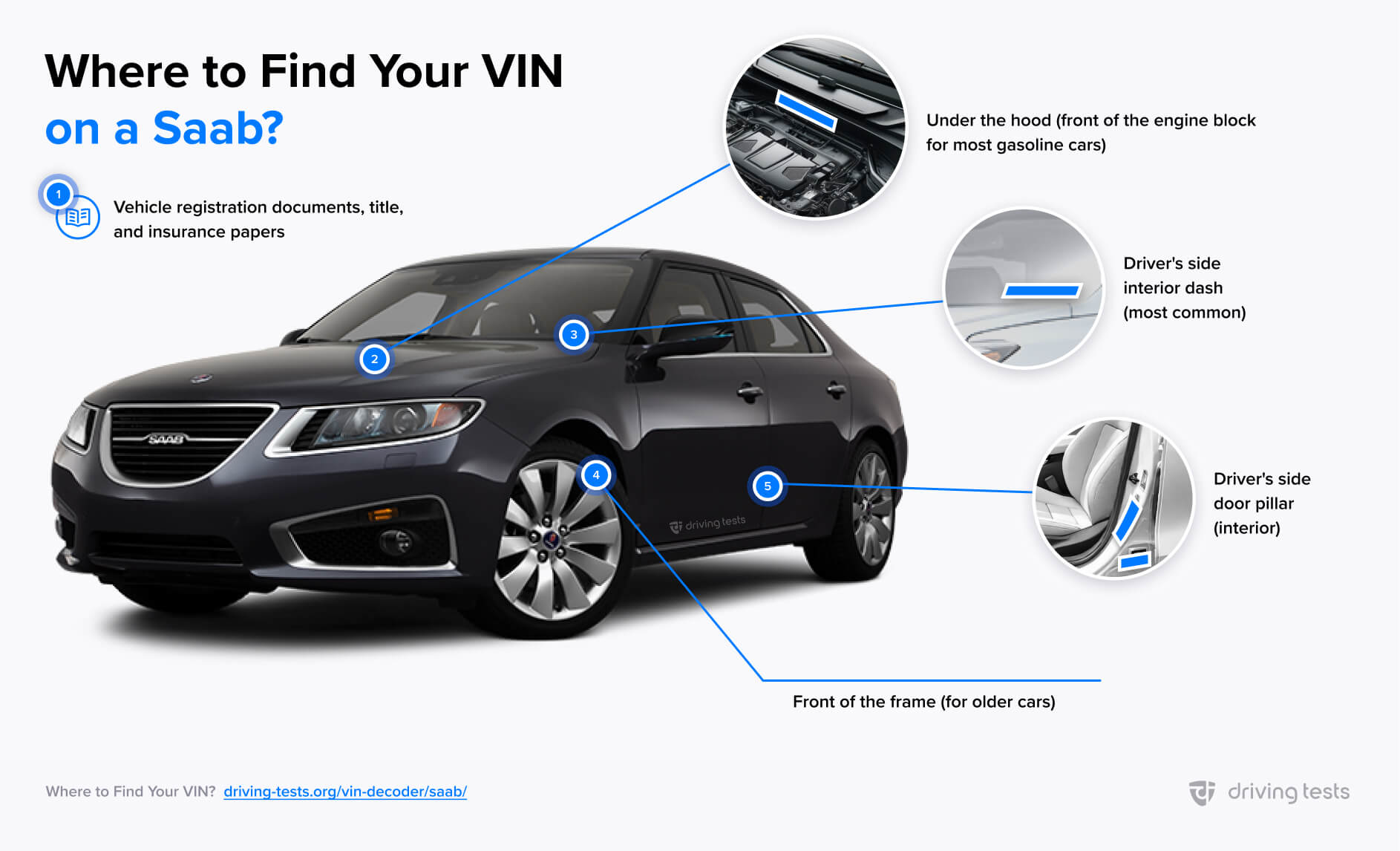Free Saab VIN Decoder & Lookup
Decode your Vehicle Identification Number for free
- Official data from NHTSA
- Most recent recalls
- Most recent complaints
| Manufactured By | - |
| Plant Company Name | - |
| Vehicle Type | - |
| Series | - |
| Body Class | - |
| Doors | - |
| Front Airbag Location | - |
| Seat Belts Type | - |
| Engine Displacement (CI) | - |
| Engine Displacement (CC) | - |
| Fuel Type | - |
| Engine Number of Cylinders | - |
Source: official gov. database of complaints
What is a VIN Number?
The Vehicle Identification Number (VIN) is a distinct code given to each motor vehicle during its manufacture. This 17-character alphanumeric sequence, omitting Q, I, and O to avoid mix-ups with 0 and 1, details the vehicle’s manufacturer, model, year, and production site, presented without spaces. Using Driving-tests.org is the easiest way to use a VIN decoder, it pulls straight from government data, and it's free to use.
| How many characters: |
| 17 (digits and capital letters) |
| Where to find: |
| Dashboard on the driver's side |
| First digit stands for: |
| Country of manufacturer |
How to Find It
Finding your Saab's VIN is straightforward. Here’s where to look:
- Passenger Cars: Check the front of the dashboard on the driver's side. View it from outside the vehicle through the windshield. Also, inspect the driver's side door pillar—open the door to find the VIN where the door latches.
- SUVs: Look in similar locations as passenger cars, focusing on the driver's side door pillar and the front of the dashboard.
If you're unable to locate the VIN on your Saab, it can also be found on:
- Your vehicle's title documents.
- Liability insurance documents.
How to Check a Specific Number
Enter your Saab's 17-character Vehicle Identification Number (VIN) in the field above to obtain detailed information about your vehicle. This includes specifics such as the manufacturer, make and model, body style, engine specifications, assembly plant, and model year. The data comes from the National Highway Traffic Safety Administration (NHTSA) based on information provided by Saab. Whether you own a Saab 9-3, 9-5, or any other model, this VIN Decoder tool will give you a detailed build sheet or specific chart for your vehicle. For Saab vehicles produced before 1981, the VIN may contain fewer than 17 characters.
How to Read the Different Components
Curious about what each character in your Saab's VIN stands for? Here's a breakdown:

Model Year Character Codes
The table below shows the model year character codes used in Saab VINs. These codes help you determine the exact year of manufacture for your vehicle.
- Example: A Saab 9-3 with a VIN of YS3FB49Y561123456 has a model year character of '6,' indicating it was manufactured in 2006.
- Example: A Saab 9-5 with a VIN of YS3ED49G3B1112345 has a model year character of 'B,' indicating it was manufactured in 2011.
| Brand | Code | Year | Code | Year | Code | Year |
|---|---|---|---|---|---|---|
| Saab | A | 1980 | L | 1990 | Y | 2000 |
| Saab | B | 1981 | M | 1991 | 1 | 2001 |
| Saab | C | 1982 | N | 1992 | 2 | 2002 |
| Saab | D | 1983 | P | 1993 | 3 | 2003 |
| Saab | E | 1984 | R | 1994 | 4 | 2004 |
| Saab | F | 1985 | S | 1995 | 5 | 2005 |
| Saab | G | 1986 | T | 1996 | 6 | 2006 |
| Saab | H | 1987 | V | 1997 | 7 | 2007 |
| Saab | J | 1988 | W | 1998 | 8 | 2008 |
| Saab | K | 1989 | X | 1999 | 9 | 2009 |
| Saab | L | 1990 | A | 2010 | ||
| Saab | M | 1991 | B | 2011 | ||
| Saab | N | 1992 | C | 2012 | ||
| Saab | P | 1993 | D | 2013 | ||
| Saab | R | 1994 | E | 2014 | ||
| Saab | S | 1995 | F | 2015 | ||
| Saab | T | 1996 | G | 2016 | ||
| Saab | V | 1997 | H | 2017 | ||
| Saab | W | 1998 | J | 2018 | ||
| Saab | X | 1999 | K | 2019 |
World Manufacturer Identifier (WMI)
The table below shows the World Manufacturer Identifier (WMI) codes used in Saab VINs. These codes help you determine the country of origin for your vehicle. Understanding these codes can provide insights into the manufacturing and origin of your Saab vehicle.
Brand-Specific WMIs:
- YS3 = Sweden
- 1S4 = United States
Historical Context:
Saab, a Swedish automotive brand, is known for its unique design and innovative engineering. With a strong emphasis on safety and performance, Saab has produced a range of vehicles that stand out in the automotive market.
Production Volume:
Saab's primary production facilities were located in Sweden, with additional manufacturing in the United States. This distribution helped Saab maintain its distinctive design and engineering standards while catering to different markets.
Trivia:
- The Saab 900 is one of the brand's most iconic models, known for its distinctive design and turbocharged engines.
- Saab originated as an aircraft manufacturer, which influenced its focus on aerodynamics and safety in its vehicles.
| Region | WMI | Notes |
|---|---|---|
| Europe | YS3 | Sweden |
| North America | 1S4 | United States |

